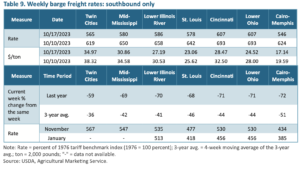Congress has quickly engaged in putting together potential aid packages for farmers that would more than double the Trump administration's $12 billion under the Farmer Bridge Assistance (FBA) Program.
Lower Mississippi River Water Levels Will Likely Persist
Reuters writer Karl Plume reported yesterday that, “Low water levels on the lower Mississippi River are likely to persist through at least January despite expected above-normal precipitation across the southern United States this winter, forecasters with the National Oceanic Atmospheric Administration (NOAA) said on Thursday.
#Drought Monitor - River Basins
— FarmPolicy (@FarmPolicy) October 19, 2023
* #MississippiRiver
* #harvest23
* #corn, #soybean exports pic.twitter.com/lSAnsEcuF0
“The severe to exceptional drought choking the lower Mississippi River valley is expected to improve this winter as the El Nino weather pattern brings better rains to the region, NOAA said in its U.S. winter weather outlook.

“But lingering drought in the upper Midwest and forecasts for normal to below-normal precipitation across basins that supply tributaries like the Illinois and Ohio rivers could slow the Mississippi River’s recovery.”

Plume explained that, “Low water has slowed export-bound barge shipments of grain from the Midwest farm belt for a second straight year during the busy fall harvest season, making U.S. exports of corn and soybeans less competitive in the world market.”
This morning, Memphis, TN was at -11.8ft and Helena, AR was at -4.6ft. Both sites have broken their all time record lows set last week and each site may continue to set records over the next few days. The remaining downstream locations are forecast to remain above record lows. pic.twitter.com/roz1lSJ4vi
— NWS LMRFC (@NWSLMRFC) October 16, 2023
The Reuters article stated that, “‘We are expecting improving drought conditions for the lower to middle Mississippi Valley during the next few months. But for the hydrological impacts such as low river levels and low ground water levels, that will be a little slower to recover,’ said Brad Pugh, operational drought lead with NOAA’s Climate Prediction Center.
“‘The hydrological impacts could linger beyond the end of January,’ he said.
Meanwhile, in is weekly Grain Transportation Report yesterday, the USDA’s Agricultural Marketing Service (AMS) indicated that, “Record Low River Gauge Along the Mississippi River System (MRS). On October 11, the Memphis, TN, water-level gauge on the Mississippi River captured an official record low of −11.52 feet. This surpasses the previous record low of −10.81 feet, from last October. On October 17, the Memphis gauge read an unofficial record low of −11.98 feet that the U.S. Army Corps of Engineers has not yet verified.
“Records were also broken on the Ohio River at Cairo, IL, where the water-level gauge read 4.5 feet, the lowest since 1901, and on the Missouri River at New Madrid, MO, where the reading was −6 feet. Draft and tow-size restrictions are in place along the entire MRS.
Despite some recent rain, more rain will be needed to raise water levels enough to improve navigation conditions.
Yesterday’s report also explained that, “Water levels are projected to rise by late October and early November, but navigation conditions are not expected to improve before late December or early January. Despite the navigation issues, last week, the St. Louis spot freight rate fell for the third week in a row to $23.06 per ton—down 68 percent from the same week last year—and 496,000 tons of grain moved through MRS locks to the U.S. Gulf.”

The AMS update added that, “For the week ending October 14, barged grain movements totaled 496,214 tons. This was 29 percent more than the previous week and 22 percent less than the same period last year.

“For the week ending October 14, 331 grain barges moved down river—84 more than last week. There were 867 grain barges unloaded in the New Orleans region, 5 percent fewer than last week.”
In other weather related news, Reuters writer Roberto Samora reported yesterday that, “Soybean farmers in top growing state Mato Grosso worry that scarce rains and high temperatures will lead to replanting of some areas while lowering yields in others, said local grain farmer lobby Aprosoja-MT on Thursday.
“The unusual heat and dryness has been linked to the El Nino weather pattern, which is also causing a severe drought that is draining Amazonian rivers and disrupting grains shipments in the North of Brazil.”
Also yesterday, Reuters writer Mark Weinraub reported that, “After a dry spring threatened to wither the U.S. corn crop in the fields, farmers are harvesting what will likely be the country’s third-largest crop ever.
“A bumper harvest will strain storage capacity and hold down prices of the world’s most traded commodity crop. This will benefit customers who will pay less for corn used to feed livestock, dairy cows and egg-laying chickens or to make ethanol biofuel. But it will squeeze profits for farmers, who will store corn and hope for new demand from exports or new domestic uses.”





